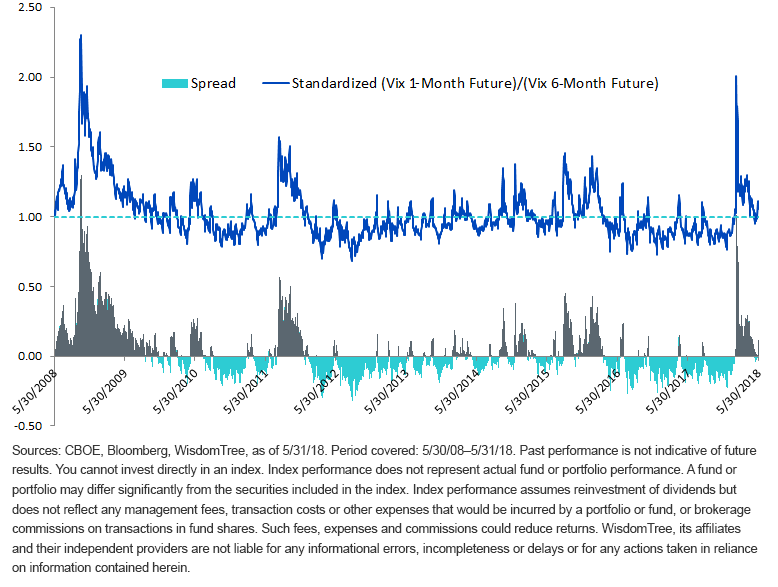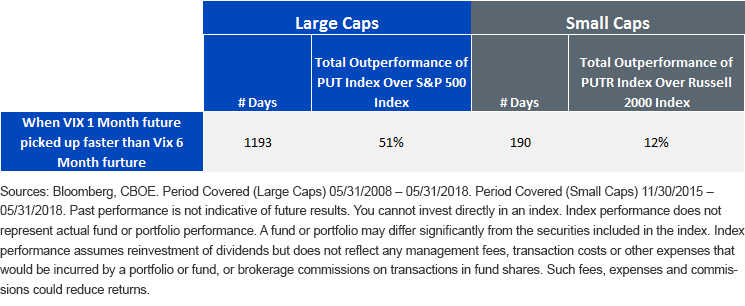WisdomTree launched its first ETFs in June of 2006, pioneering the concept of fundamental weighting. WisdomTree sponsors distinct ETFs that span asset classes and countries around the world.
What Is VIX Telling Investors?
I have written on the jump in the VIX that occurred in February , taking investors by surprise. While there was a precursor to this unprecedented surge in the VIX (a compression of spreads between implied minus realized volatility ), it was subtle and the move was very sudden. VIX moves are important due to their strong negative correlation to equities.
In this blog post, I will highlight another relatively more stable signal we have been following and the one that has been flashing red for some time, the VIX futures curve. I will also talk about strategies that can cushion market corrections that typically follow periods of heightened volatility .
VIX Futures Curve : A Signal to Watch
The VIX is indicative of one-month implied or forward volatility. When there is a spike in the VIX, it simply means investors anticipate higher volatility in the future.
Now, most investors are aware of term-structure curves in relation to commodity futures curves . Similarly, VIX can also have a futures curve where different points in the curve imply investors’ anticipation of implied volatilities at that time.
Under normal circumstances, as one moves further out in the future on the curve, corresponding values should be higher, partly because six months have more uncertainty than, say, one month.
In other words, usually six-month minus one-month VIX futures spreads should be positive. Commodity traders refer to this upward sloping nature of a futures curve as being in “contango,” and it also implies a roll cost every month—why investors structurally long in volatility-hedging products face a strategic headwind.
The exhibit below shows a standardized series of VIX one-month and six-month futures contracts going back 10 years. Out of about 2,610 trading days, there were about 1,193 days (46% of time) when the one-month standardized VIX was higher than the standardized six-month VIX.
To put it simply, VIX one-month futures surged faster than VIX six-month futures (highlighted in red on the lower chart). It happened during the financial crisis of 2008–09 and during the Greek default and euro-contagion in 2011, and most recently this inversion started on January 29, right before a big spike in VIX on February 5 ahead of the substantial decline in equities in the weeks that followed.
An acceleration in the near-term over medium-term VIX can thus be a strong signal of heightened volatility and possible market corrections.
What can take investors by surprise is that with an occurrence rate of almost 50% (1,193 days out of 2,610 days), this acceleration is not uncommon!
VIX 1-Month Volatility Surpasses VIX 6-Month
How WisdomTree Can Help?
Can investors mitigate these periods of high volatility?
In 2016, WisdomTree launched its first option-selling strategy, the WisdomTree CBOE S&P 500 PutWrite Strategy Fund (PUTW) , which tracks the Cboe S&P 500 PutWrite Index (PUT) .
This cash-collateralized strategy sells at-the-money (ATM) monthly put options on the S&P 500 Index and collects premiums . Therefore, by generating monthly income by selling put options, this strategy aims to offset losses in a declining market while still providing positive returns during rising markets.
Given PUTW’s popularity and track record, we also launched a small-cap version of the same strategy, the WisdomTree CBOE Russell 2000 PutWrite Strategy Fund (RPUT) , which tracks the Cboe Russell 2000 PutWrite Index (PUTR) and sells cash-collateralized monthly ATM options on the Russell 2000 Index .
The table below highlights the relative cumulative outperformance of these option-selling strategies against their respective equity benchmarks during above-discussed periods when short-term volatility surged.
For definitions of terms in the chart, please visit our glossary .
Taking it one step further, I also show the five longest instances in which VIX one-month futures constantly traded higher than VIX six-month futures, for large - and small-cap universes.
Large Caps
PUT Index vs S&P 500 Index

Small Caps
PUTR Index vs Russell 2000 Index
Options selling strategies did what they were designed to do: outperform their respective equity indexes, which were mostly trading negative for those days when volatility had spiked.
Conclusions
Short-term investors try to time markets by developing and watching various signals to time risk on or off, while long-term investors go by a simple rule: Time spent in the market is more important than timing the markets. What connects the two investing themes: To grow your portfolio, your asset allocation should be able to survive the cyclicality of markets’ booms and busts.
Strategies designed to help reduce volatility, such as WisdomTree’s PUTW and RPUT, deserve attention to help stay the course without introducing unique stock selection risk of other low-volatility investment strategies. By incorporating option strategies, investors could outperform not only during periods of stress but also potentially on a longer-term risk-adjusted basis. Additionally, option-selling strategies have the potential to generate higher income for an investor’s portfolio during periods of heightened volatility. We believe PUTW and RPUT are compelling candidates for any risk-sensitive equity asset allocation.
RSS Import: Original Source
Investors should carefully consider the investment objectives, risks, charges and expenses of the Funds before investing. U.S. investors only: To obtain a prospectus containing this and other important information, please call 866.909.WISE (9473), or click here to view or download a prospectus online. Read the prospectus carefully before you invest. There are risks involved with investing, including the possible loss of principal. Past performance does not guarantee future results.
You cannot invest directly in an index.
Foreign investing involves currency, political and economic risk. Funds focusing on a single country, sector and/or funds that emphasize investments in smaller companies may experience greater price volatility. Investments in emerging markets, real estate, currency, fixed income and alternative investments include additional risks. Due to the investment strategy of certain Funds, they may make higher capital gain distributions than other ETFs. Please see prospectus for discussion of risks.
WisdomTree Funds are distributed by Foreside Fund Services, LLC, in the U.S. only.




